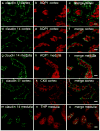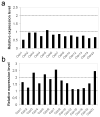Double gene deletion reveals lack of cooperation between claudin 11 and claudin 14 tight junction proteins
- PMID: 18663477
- PMCID: PMC2943968
- DOI: 10.1007/s00441-008-0621-9
Double gene deletion reveals lack of cooperation between claudin 11 and claudin 14 tight junction proteins
Abstract
Members of the claudin family of proteins are the main components of tight junctions (TJs), the major selective barrier of the paracellular pathway between epithelial cells. The selectivity and specificity of TJ strands are determined by the type of claudins present. An understanding of the cooperation between different claudins in various tissues is thus important. To study the possible cooperation between claudin 11 and claudin 14, we have generated claudin 11/claudin 14 double-deficient mice, which exhibit a combination of the phenotypes found in each of the singly deficient mutants, including deafness, neurological deficits, and male sterility. These two claudins have distinct and partially overlapping expression patterns in the kidney. Claudin 11 is located in both the proximal and distal convoluted tubules, whereas claudin 14 occurs in both the thin descending and thick ascending limbs of the loop of Henle and in the proximal convoluted tubules. Although daily urinary excretion of Mg(++), and to a lesser extent of Ca(++), tends to be higher in claudin 11/claudin 14 double mutants, these changes do not reach statistical significance compared with wild-type animals. Thus, under normal conditions, co-deletion of claudin 11 and claudin 14 does not affect kidney function or ion balance. Our data demonstrate that, despite the importance of each of these claudins, there is probably no functional cooperation between them. Generation of additional mouse models in which different claudins are abolished should provide further insight into the complex interactions between claudin proteins in various physiological systems.
Figures




References
-
- Acharya P, Beckel J, Ruiz WG, Wang E, Rojas R, Birder L, Apodaca G. Distribution of the tight junction proteins ZO-1, occludin, and claudin-4, -8, and -12 in bladder epithelium. Am J Physiol Renal Physiol. 2004;287:F305–318. - PubMed
-
- Angelow S, El-Husseini R, Kanzawa SA, Yu AS. Renal localization and function of the tight junction protein, claudin-19. Am J Physiol Renal Physiol. 2007;293:F166–177. - PubMed
-
- Ben-Yosef T, Belyantseva IA, Saunders TL, Hughes ED, Kawamoto K, Van Itallie CM, Beyer LA, Halsey K, Gardner DJ, Wilcox ER, Rasmussen J, Anderson JM, Dolan DF, Forge A, Raphael Y, Camper SA, Friedman TB. Claudin 14 knockout mice, a model for autosomal recessive deafness DFNB29, are deaf due to cochlear hair cell degeneration. Hum Mol Genet. 2003;12:2049–2061. - PubMed
Publication types
MeSH terms
Substances
Grants and funding
LinkOut - more resources
Full Text Sources
Molecular Biology Databases

